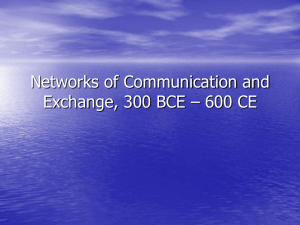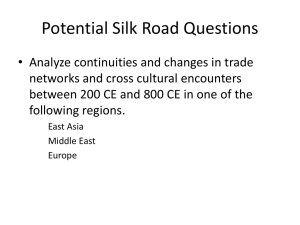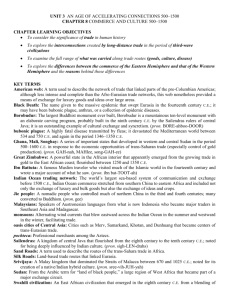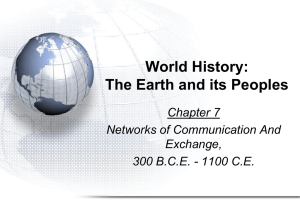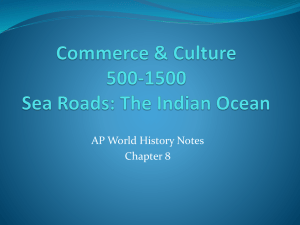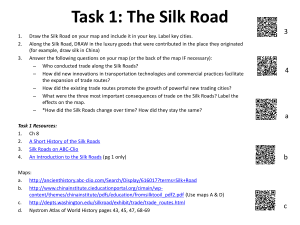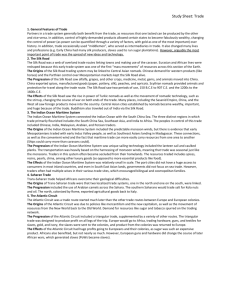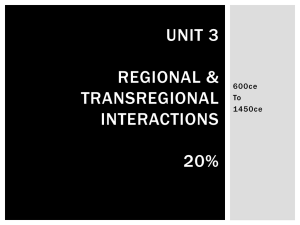Commerce & Culture: 3rd Wave Civilizations - Trade Networks
advertisement
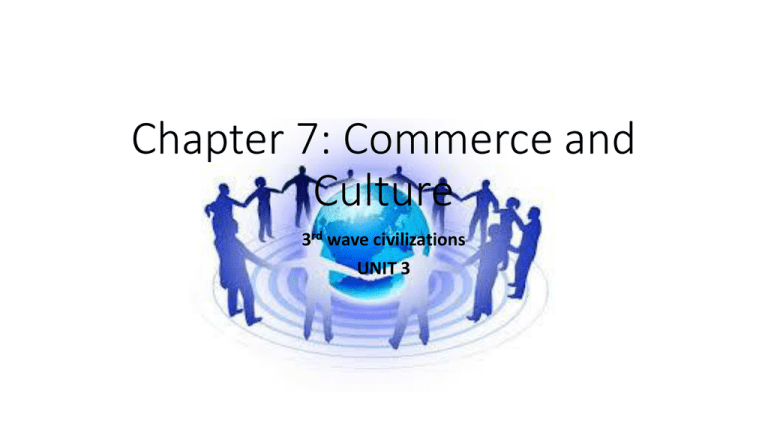
Chapter 7: Commerce and Culture 3rd wave civilizations UNIT 3 Economic Globalization • Why was trade significant • • • • • • • • Altered consumption Encouraged specialization Diminished economic self-sufficiency Traders became distinct social groups Sometimes a means of social mobility Provided goods for the elite (usually) Sometimes created state creation Other ideas, innovations, diseases, animals and plants were spread Silk Road Exchange across Europe • Silk Roads form one of the world’s extensive and sustained networks of exchange • Relay of trade • Provided unity and coherence in Eurasian history • The Growth of the Silk Road • Eurasia divided in “inner” and “outer” zones • Outer- relatively warm, well watered (China, India, Middle East, Mediterranean) • Inner- harsher, drier climate and pastoral (Eastern Russia and Central Asia) • Creation of 2nd wave civilizations/imperial states tried to control pastoral people • Trading networks did best when security was provided by states • Roman and Chinese anchored commerce • 7th and 8th C- Byzantine, Abbasid and Tang dynasty • 13th and 14th C Mongols Goods in Transit • Many goods, usually by camel • Luxury goods for elite • High cost of transport did not allow movement of staples • Silk symbolized Eurasian exchange • China had the monopoly on silk at first • By 6th C- others were producing • Silk was used a currency in Central Asia • Silk was symbol of status • Volume of trade • Peasants in the Yangzi River delta of S China produced market goods • Silk, paper, porcelain • Well placed individuals could make enormous profits Products that contributed to Silk Road Exchange • China: silk bamboo, mirrors, gunpowder, paper, rhubarb, ginger, lacquer ware, chrysanthemums • Siberia and Central Asia: furs, amber, livestock, horses, falcons, hides, copper vessels, tents, saddles, slaves • India: cotton textiles, herbal medicine, precious stones, spices • Middle East: dates, nuts, almonds, dried fruit, dyes, lapis lazuli (ore to make blue dye), swords • Mediterranean: gold coins, glassware, glazes, grapevines, jewelry, artworks, perfume, wool and linen textiles, olive oil Culture in Transit • Cultural transmission was more important than exchange of goods • Buddhism • • • • • Spread Appealed to merchants Conversion was heavy in oasis cities and was voluntary In China was the religion of foreign merchants and rulers Transformed during its spread Spread of Buddhism Spread of Hinduism (Blue route) What accounted for the spread of Buddhism along the Silk Roads? • Your Turn: Disease in transit • Major populations in Afro-Eurasian world developed disease patterns • Long distant trade meant exposure to new diseases • Early case- Athens • Roman and Han empires • 534-750 CE • The Black Death • Spread because of the Mongols- thanks Mongols (remember spread 13th and 14th C) • Bubonic plague ?/ anthrax? • Killed up to ½ of European population in 1346-1350 • Similar death toll in China and Islamic World • European advantage • Western hemisphere after 1500s- Columbian Exchange What was the impact of disease along the Silk Roads? • Your turn: Sea Roads- Indian Ocean Indian Ocean Trade- LOOK up the word COMMERCE! • History • Mediterranean Sea- from the time of the Phoenicians • Venice was center by 1000 CE • Controlled trade of imports from Asia • Linked Europe to the much greater trade networks of Indian Ocean • Indian Ocean network • • • • • Trade grew from environmental and cultural diversity Transportation was cheaper by sea than land Bulk goods Monsoons Commerce was between towns- not states Lateen Sails: dhow The exact origins of the dhow are lost to history. Most scholars believe that it originated in China from 600 B.C. to 600 A.D. ►Lateen Sail allowed sailors to sail across the Indian ocean, could sail into wind Weaving the Web of an Indian Ocean World • Indian Ocean trade started in the 1st wave of civilization • Indus valley writing may have been stimulated by cuneiform (who had this?) • Ancient Egypt/Phoenicians traded down the Red Sea • Malay sailors reached Madagascar in BCE • Tempo of commerce increased in early centuries with understanding of the monsoon • Merchants from Roman empire settled in S. India and E Africa coast • Growing trade in E Indian Ocean and S China Sea • Center of trade was India • Two great encouragers for Indian Ocean trade • Economic and political revival of China • Rise of Islam in 7th C (friendly to commercial life) • Developed communities- spread their faith Sea Roads as a Catalyst for Change: SE Asia • Ocean commerce transformed SE Asia and E Africa • Stimulated political change • Introduced foreign religious ideas • SE Asia • Malay sailors opened all-sea route through Straits of Malacca 350 CE • Small sea ports competed to attract traders • Malay Kingdom • Srivijaya- dominated trade from 670-1025 CE • Gold, spices, taxes on ships created state • Inland States based on rice production also participated • Funan- 0-600 CE (Vietnam and E Cambodia) • Khmer kingdom- Angkor (800-1300 CE) forest products • Champa- Vietnam- tried to control trade and provoked warfare • Elements of Indian culture spread to SE Asia, Chinese culture to Vietnam • Indian alphabets, artistic forms, political and religious ideas (Buddhism) • Sailendras Kingdom- Central Java influenced from India • Massive building of Hindu and Buddhist centers • Shows Buddhist cultural grounding • Hinduism • SE Asia, Champas and Angkor areas • “Indianization” • Mixed Indian ideas and practices with existing • Little conflict • Less patriarchal tradition • Islam came later Products from Indian Ocean Trade ►Mediterranean—ceramics, glassware, wine, gold, olive oil ►East Africa—ivory, gold, iron goods, slaves, tortoiseshells, quartz, leopard skins ►Arabia—frankincense (desired far beyond Indian Ocean world), myrrh, perfumes ►India—grain, ivory, precious stones, cotton textiles, spices, timber ►SE Asia—tin, sandalwood, cloves, nutmeg, mace ►China—silks, porcelain, tea Influence of Buddhism in Java Hindu temple in Java Sea Roads as a Catalyst for Change: E Africa • History of Swahili Civilization • Blend of Bantu and Islamic Indian Ocean life • East Africa Coast- 1000-1500 CE • Urban • Cities politically independent • Ruled by a king • Most of trade was in Arab ships • Deep participation in the Indian Ocean World • Regular visitors from Arab, Indian and Persian merchants • Swahili was written in Arabic script • Spread conversion of Islam • Islam and Swahili culture didn’t reach much beyond coast until the 19th c • Traded with interior had an impact • Trade with interior for gold led to Great Zimbabwe (1250-1350 CE) What was the role of Swahili civilization in the world of Indian Ocean commerce? • Your Turn: To what extent did the Silk Roads and the Sea Roads operate in a similar/different fashion? • Your turn: Silk Road Sea Road Similar Similar Different Different Africa West African Trade Routes Sand Roads: Exchange Across the Sahara • Commercial Beginnings in W Africa • Based on environmental variation • N Africa- manufactured goods • Sahara- copper, salt and dates • Earliest Trade • People among the Sudan • Emergence of urban clusters • Jenne-Jeno (Niger Valley Civilization) • Gold, Salt and Slaves • Camel • Regular trans-Saharan commerce by 300 CE • Merchants really wanted gold • Sahara become international trade route • Trade encouraged new political structures • Ghana, Mali, Songhay, Kanem, Hausa • Monarchies- elaborate court life • Slavery • West Africa, mostly women • Male slaves- porters, craftsmen, miners, laborers • Raided from further South The Americas An American Network: Commerce and Connection in the Western Hemisphere • NO interaction between E. and W. until Columbus • American trade networks were not as dense as Afro-Eurasian • Important limitations • Lack of domesticated large mammals, wheeled vehicles, large ocean going ships • Geographical/environmental obstacles • “Loosely interactive web”- Great Lake to Andes • • • • • Cultural elements spread gradually Cahokia was center of widespread trading network Amazon and Orinoco river exchange Caribbean peoples had interisland trade Chincha people traded along Pacific Coast of S America • Major trade network in Mesoamerica • • • • Chaco canyon culture interacted with Mesoamerica Maya and Teotihuacan traded by land Maya traded by Sea on BOTH coasts (dugout canoes) Aztecs by 15th C had professional merchants - pochteca • Major trade network in Andes was state run • Inca distributed supplies from great state storehouses • 20,000 miles of road • Some local exchange at fairs along borders of empire Mesoamerica Andes/Incan Road System Continuities and Change • Changes Move from barter to coins as system of exchange Greater interaction between civilizations – direct links between Rome and China Cultural diffusion through trade – spread of religion, architecture, disease Decline in trade in Europe after fall of Rome • Continuities Dominance of India in trade The importance of the Silk Road and maritime trade routes Constantinople as western trade hub
